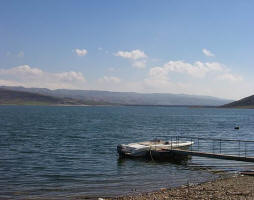 Jordan: Groundwater to save the capital, for a while
Jordan: Groundwater to save the capital, for a while
Bundles of
massive pipes lay along the 30 kilometre road from
With only 90
litres of water available for use per capita a day,
affected by the
delays in the southern area. Once operational, the project will provide the
capital with 100 million cubic metres of drinking water per year for about 100
years, before it is depleted. Jordanian authorities have other cards on their
planning table, such as desalination in line of a conveyance canal linking the
the Dead Sea, supplying enough hydroenergy in the process to make up for maintaining much aspired desalination, nuclear power and other plants.
Local bananas
bid to manage
the demand for domestic water use in urban areas. However, rapid, urban, demographic,
climate and economic changes require stricter measures as the country tries to
find new resources and use the current resources as effectively as possible. For
example, much can be done to avoid waste in other sectors such as agriculture
in the
Driving towards
the valley, a horizon of banana trees stretches over the area north of the
Jordan Valley Authority chief Saad Abu Hammour, who is the responsible for water allocation in the area, they had to decrease water used for irrigating citrus trees in the area in 2010, as three dams feeding the area ran out of water due to draught. He says rain accumulation has dropped severely due to climate change in the past two decades, while
heat waves in winter have been forcing farmers to use scarce water resources to cool off already thirsty farmland. Asked whether the water ministry should do something about banana production, which consumes more water than many other options, Abu Hammour commented that this is not the water ministry’s job. “This task should be allocated to the
Ministry of Agriculture, not ours.” He comments that scientists offer solutions, but offer no definitive expectations on how climate changes will affect the region. Meanwhile, the authority continues to work on managing the little water resources they have access to.
“But, what shall I do to solve the rain shortage?” he asks himself. “I can only pray that God will send more water”
| Contact information | n/a |
|---|---|
| News type | Inbrief |
| File link |
http://www.siwi.org/ |
| Source of information | Stockholm International Water Institute |
| Keyword(s) | water resource management, water resource, drought, drinking water, domestic treatment, Climatic change, rain water, river-groundwater exchange |
| Subject(s) | ANALYSIS AND TESTS , CHARACTERISTICAL PARAMETERS OF WATERS AND SLUDGES , DRINKING WATER , DRINKING WATER AND SANITATION : COMMON PROCESSES OF PURIFICATION AND TREATMENT , HEALTH - HYGIENE - PATHOGENIC MICROORGANISM , HYDRAULICS - HYDROLOGY , INFORMATION - COMPUTER SCIENCES , INFRASTRUCTURES , MEASUREMENTS AND INSTRUMENTATION , POLICY-WATER POLICY AND WATER MANAGEMENT , PREVENTION AND NUISANCES POLLUTION , RIGHT , RISKS AND CLIMATOLOGY , SANITATION -STRICT PURIFICATION PROCESSES , WATER DEMAND , WATER QUALITY |
| Geographical coverage | Jordan, |
| News date | 09/05/2011 |
| Working language(s) | ENGLISH |
 you are not logged in
you are not logged in





